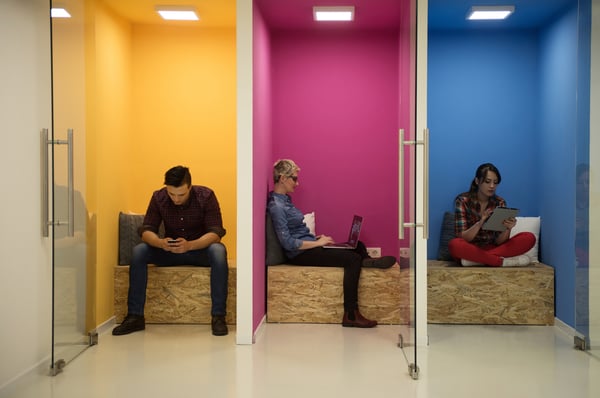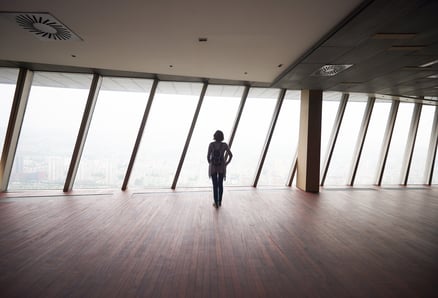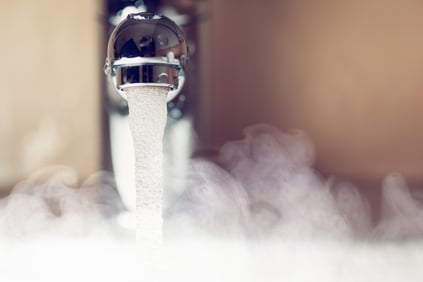
Recommendations for promoting workplace health and wellbeing often include monitoring the indoor environment using wearable sensors. Our view is that a fixed sensor...
In March 2020, the Chartered Institute for Building Service Engineers (CIBSE) published an update to their TM40 guidelines titled Health and Wellbeing in Building Services. It discusses principles that place wellbeing at the centre of building design and management.
This article summarises the key points.

TM40 aims to present a set of guidelines for supporting health and wellbeing in the built environment.
It’s a remit that goes beyond building regulations and health and safety requirements, intended to inform the design and management of buildings rather than to lay out rules or regulations. Probably due to its broad scope, TM40's tone is a lot more discursive than suggested by its classification as a technical memorandum (TM).
It focuses mostly on homes and workplaces. It is explicitly not intended to cover healthcare buildings like hospitals and care homes which have specialised requirements.
Although it wasn't published until March, it was written before the COVID-19 pandemic. CIBSE published an addendum in April 2020 [PDF] that relates the TM40 guidelines to the pandemic as it was understood at that time. This summary draws from both the original TM40 document and the April addendum.
CIBSE have posted an hour-long webinar on TM40, which summarises the key points:
The guiding principle of TM40 is that buildings should be designed and managed around their users.
It makes various recommendations for design, which can be applied at various levels from the broad scope of town planning down to the layout and service provision for individual rooms. Some key themes are:
The importance of site assessment appears in every section dealing with a specific wellbeing issue, emphasising the need for building service provision to be tailored to the location of the building.
TM40 recommends that a building's first year of occupancy should be treated as an extended commissioning period, with an independent commissioning manager overseeing post-occupancy evaluations that draw on the occupants' experience and liaise with the design team to address any issues that are identified.
TM40 recommends that facilities managers should set and measure targets for wellbeing, which may be objective and quantifiable such as temperature or indoor air quality or may be more subjective such as by asking office staff to rate the comfort of their workplace.
TM40 contains an extensive discussion of how incorporating potted plants, external views of nature or even patterns inspired by nature can improve the wellbeing of a building's occupants.
As a building may last for decades, design must consider not only the first people to occupy it but also those who will occupy it in the future. A new building needs to be comfortable in the warmer climate of several years in the future.

Most of the TM40 document is concerned with discussions of various parameters of the indoor environment and how a building can be designed and managed for each of them. The salient points from each chapter are summarised below:
Most people are most comfortable at 20-25°C (68-77°F). For buildings in which temperature can be finely controlled by electrical and mechanical heating, ventilation and cooling, a setpoint temperature should be defined using the predicted mean vote (PMV) methodology described in the BS EN ISO7730 standard.
'Free-running' buildings, which depend on opening windows for cooling and ventilation, cannot control their temperatures to the same level of precision so the occupants need to be able to adjust to a fluctuating temperature. In particular, if a free-running building is a workplace, any dress code should be loose enough to allow each person to dress for their own comfort as the temperature fluctuates.
Thermal comfort is the area most likely to be impacted by global warming so summer overheating needs to be a major design consideration. TM40 recommends modelling indoor temperatures using CIBSE's data files that project the likely summer temperatures in the UK early in the design process.
The ideal relative humidity is 40-70%, although it is recommended that it should be below 60% in homes or in any building where it can be controlled by mechanical air conditioning.
High humidity promotes fungal growth and enhances the release of volatile organic compounds (VOCs) while low humidity causes the mucous membranes to dry out, which makes the occupants uncomfortable and vulnerable to respiratory virus infection.
The chapter deals with gas pollutants and carbon particles.
Carbon dioxide levels have often been used to measure how well a room is ventilated but recent research suggests that even a slight rise in the carbon dioxide level may impair cognitive performance.
CIBSE's recommendations for responding to the COVID-19 pandemic quote the Federation of European Heating, Ventilation and Air Conditioning Associations (REHVA), who state that ventilation should be maximised to remove droplets carrying the virus from a building before they settle on surfaces. They state that a ventilation system should maintain a through-flow of air sufficient to keep the carbon dioxide levels at the 400ppm level [PDF] typical of outside air.
TM40 divides other contaminants into those produced indoors and outdoors:

Indoor pollutants are mostly nitrous oxides (NOx) and carbon particles produced by cooking, microbiological contaminants such as fungal spores and VOCs. The latter are ubiquitous and encompass a broad range of mostly harmless substances although the most harmful is formaldehyde which is mostly released by paint.
Outdoor pollutants are mostly nitrous oxides (NOx) and particulate matter classified as either PM2.5, with a diameter of 2.5µm or less or the larger PM10 with a diameter of 10µm or less. Many processes produce both NOx and particulates but from the perspective of most buildings, the major sources are usually traffic or industrial processes outside but close to the building.
The placing of the inlet of a ventilation system is critical to ensuring that the air drawn into the building is the cleanest available to it. Carbon filters can also play a role in removing the worst of the particulates.
A ventilation system is itself a source of outdoor pollution as it concentrates a building's indoor pollutants and expels them through a single exhaust. The expelled compounds disperse rapidly but a common design flaw is to place the exhaust too close to the inlet so that the indoor pollutants are drawn back into the building.
In developments where buildings are placed close together, they must be planned so that one building's inlet is not drawing air from another's exhaust.
 Light
LightTM40 discusses the importance of lighting making a workplace comfortable: poor lighting causes eyestrain while flickering or direct glare is distracting and uncomfortable. Well-planned lighting avoids both those problems and can contribute to wellbeing by complementing the circadian rhythm.
What makes for well-planned lighting varies according to the purpose and orientation of the building. Other than avoiding the problems above, the only clear recommendation is to use natural light as much as possible.
The detrimental effects of noise fall into two categories:
Background noise that is loud enough to interfere with conversation, making it difficult to hold a conversation or listen to radio or television.
Even at levels low enough that it is easy to talk over, persistent background noise is annoying and interferes with sleep, making it detrimental to mental health.
A site assessment should consider likely outside sources of noise and whether they may make it impractical to ventilate the building by opening windows. Ventilation itself can be cause non-auditory effects as case studies by Zero Carbon Hub and by Innovate UK have identified poorly designed ducts as a source of persistent and irritating noise.
TM40 goes on to discuss the potential of acoustic attenuation in a ventilation system and what it describes as acoustic ecology: the promotion of pleasant noises within the built environment such as through incorporating water features.
It also mentions recent developments to the technology of active noise-cancelling headphones intended for use in indoor spaces. Noise cancellation works by destructive interference created using 'opposite sound' to silence intrusive noise.
Active noise-cancellation systems such as Silentium apply the same approach to deaden the sound in a room without the need for the occupants to wear headphones. They are not widely used at present but may become more common in the near future.
TM40 only discusses sound in terms of eliminating intrusive noise. TM40 does not discuss situations where a designer may wish to enhance the acoustic properties of a room, such as in a room used for meetings or presentations.
Since mobile phones and wifi have brought microwaves into the indoor environment, there has been concern about their effects on health and wellbeing. As we have discussed elsewhere, those microwaves are far too weak to affect anyone's health although simply knowing they are there makes some people anxious.
Energy fields are only likely to impact health at the sort of levels used in industrial applications covered the guidelines published by the International Commission on Non-Ionizing Radiation Protection (ICNIRP) and the relevant health and safety regulations [PDF].
The chapter on water quality focuses on provision of fresh water without discussing hot water supplies or sanitation. Mains water quality is covered by stringent regulations so the main design  parameter is to ensure it is available wherever it is needed.
parameter is to ensure it is available wherever it is needed.
Water typically leaves a tap at around 10°C (50°F) although temperature fluctuates with the season. It must be reported if it is above 20°C (68°F) and may never exceed 25°C (77°F) so design for summer overheating may involve chilling the water supply in some buildings.
Water quality is the responsibility of the water supplier rather than the building designer but TM40 does discuss the microplastic granules found in the UK water supply. Water treatment removes the vast majority of microplastics [PDF] before the water enters the mains and there is currently no evidence that the small amount remaining is a health risk. However, TM40 raises the possibility that if a risk is identified in the future, buildings may need taps with advanced filtration systems.
If you would like to know how the Atamate platform can address the issues raised in TM40 or would like more information on TM40 itself, ask us on the form and we'll be happy to let you know.

Recommendations for promoting workplace health and wellbeing often include monitoring the indoor environment using wearable sensors. Our view is that a fixed sensor...

In 2017, the Chartered Institution of Building Services Engineers (CIBSE) published TM59: Design methodology for the assessment of overheating risk in homes, a...